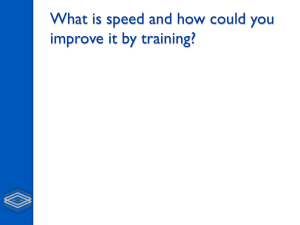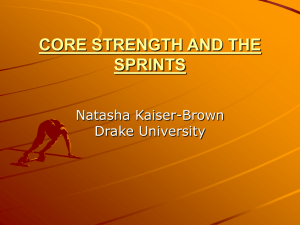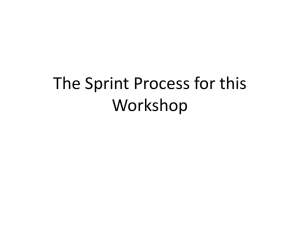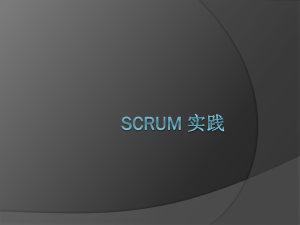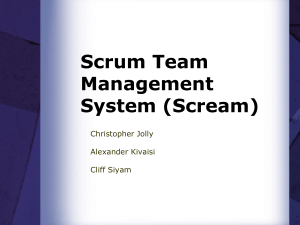Writing in Book Sprints (OER13 Conference
advertisement
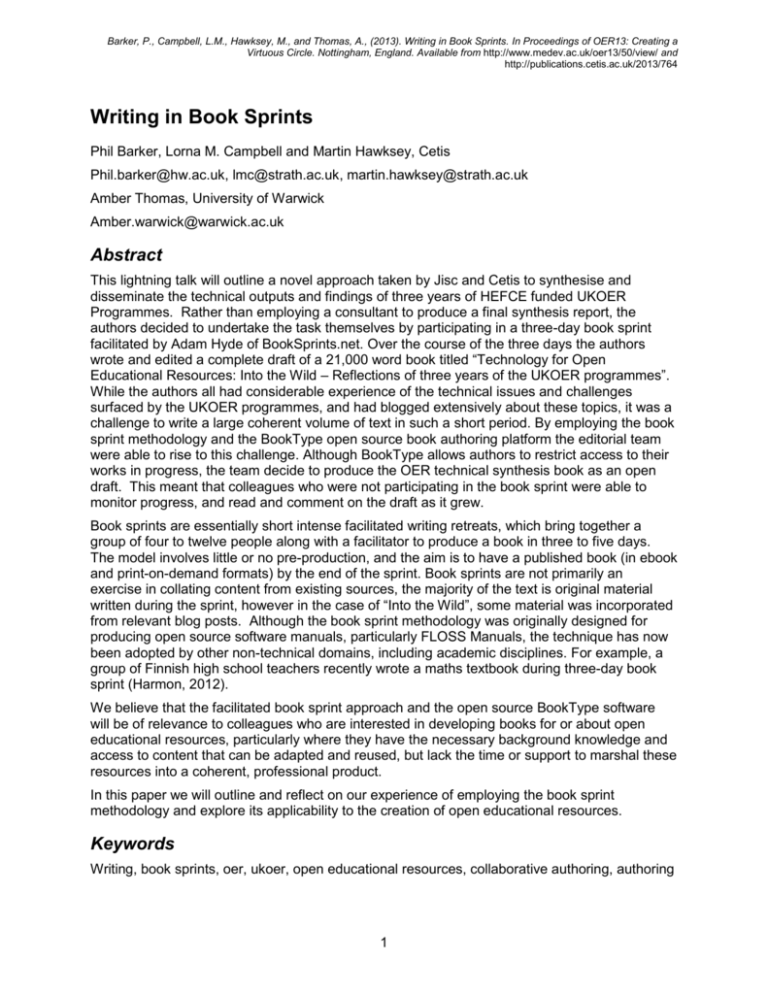
Barker, P., Campbell, L.M., Hawksey, M., and Thomas, A., (2013). Writing in Book Sprints. In Proceedings of OER13: Creating a Virtuous Circle. Nottingham, England. Available from http://www.medev.ac.uk/oer13/50/view/ and http://publications.cetis.ac.uk/2013/764 Writing in Book Sprints Phil Barker, Lorna M. Campbell and Martin Hawksey, Cetis Phil.barker@hw.ac.uk, lmc@strath.ac.uk, martin.hawksey@strath.ac.uk Amber Thomas, University of Warwick Amber.warwick@warwick.ac.uk Abstract This lightning talk will outline a novel approach taken by Jisc and Cetis to synthesise and disseminate the technical outputs and findings of three years of HEFCE funded UKOER Programmes. Rather than employing a consultant to produce a final synthesis report, the authors decided to undertake the task themselves by participating in a three-day book sprint facilitated by Adam Hyde of BookSprints.net. Over the course of the three days the authors wrote and edited a complete draft of a 21,000 word book titled “Technology for Open Educational Resources: Into the Wild – Reflections of three years of the UKOER programmes”. While the authors all had considerable experience of the technical issues and challenges surfaced by the UKOER programmes, and had blogged extensively about these topics, it was a challenge to write a large coherent volume of text in such a short period. By employing the book sprint methodology and the BookType open source book authoring platform the editorial team were able to rise to this challenge. Although BookType allows authors to restrict access to their works in progress, the team decide to produce the OER technical synthesis book as an open draft. This meant that colleagues who were not participating in the book sprint were able to monitor progress, and read and comment on the draft as it grew. Book sprints are essentially short intense facilitated writing retreats, which bring together a group of four to twelve people along with a facilitator to produce a book in three to five days. The model involves little or no pre-production, and the aim is to have a published book (in ebook and print-on-demand formats) by the end of the sprint. Book sprints are not primarily an exercise in collating content from existing sources, the majority of the text is original material written during the sprint, however in the case of “Into the Wild”, some material was incorporated from relevant blog posts. Although the book sprint methodology was originally designed for producing open source software manuals, particularly FLOSS Manuals, the technique has now been adopted by other non-technical domains, including academic disciplines. For example, a group of Finnish high school teachers recently wrote a maths textbook during three-day book sprint (Harmon, 2012). We believe that the facilitated book sprint approach and the open source BookType software will be of relevance to colleagues who are interested in developing books for or about open educational resources, particularly where they have the necessary background knowledge and access to content that can be adapted and reused, but lack the time or support to marshal these resources into a coherent, professional product. In this paper we will outline and reflect on our experience of employing the book sprint methodology and explore its applicability to the creation of open educational resources. Keywords Writing, book sprints, oer, ukoer, open educational resources, collaborative authoring, authoring 1 Barker, P., Campbell, L.M., Hawksey, M., and Thomas, A., (2013). Writing in Book Sprints. In Proceedings of OER13: Creating a Virtuous Circle. Nottingham, England. Available from http://www.medev.ac.uk/oer13/50/view/ and http://publications.cetis.ac.uk/2013/764 Introduction Between 2009 and 2012 HEFCE funded a programme of activities aimed to stimulate the release of open educational resources by Higher Education Institutions. The UKOER Progamme was managed jointly by the HE Academy and Jisc. Cetis, the national innovation support centre for educational technology and interoperability standards, provided strategic advice and support on technology and digital infrastructure directions throughout the UKOER programmes. Early in 2012, Jisc and Cetis decided that the technical issues and directions surfaced by UKOER should be collated in a form that better reflected the summative experiences of the programmes and was easier to navigate than the working blog posts and wikipages produced over the course of the programmes. We concluded that Cetis should produce a book or series of papers summarising and reflecting on the technical outputs outputs of all three UKOER programmes. For some months, little progress was made with the book, while we occasionally discussed it in abstract terms, little was done to progress the actual writing. All members of the team had other commitments and priorities with more immediate deadlines. Just as we were on the point of concluding that we were not making sufficient progress and needed to take decisive action we were fortunate to hear Adam Hyde presenting about book sprints. What is a book sprint? According to BookSprints.net: “A Book Sprint brings together a group to produce a book in 3-5 days. There is no preproduction and the group is guided by a facilitator from zero to published book. The books produced are high quality content and are made available immediately at the end of the sprint via print-on-demand services and e-book formats.” Book sprints require people to collaborate closely and intensely while staying focussed on the task in hand. This is achieved through a mix of synchronous working, co-location, facilitation and technology that supports the whole process from conceptualising the book, through collaborative authoring, to formatting and distribution. In this regard, book sprints may also be regarded as accelerated facilitated writing retreats. In the past, book sprints have been used successfully to produce technical documentation, originally for FLOSS manuals, and latterly by Google to document the Melange platform and other software created during their Summer of Code initiative. The process is not limited to the genre of technical documentation, other titles produced by book sprints include a resource book documenting places of environmental and ecological interest in Cairo, a book on Andre Malraux’s psychology of art, governmental oil contracts, aesthetics and a mathematics textbook. The stages of a book sprint have been neatly summarised by D. Berry and M. Dieter (Berry and Dieter, n.d.): 1. 2. 3. 4. Concept Mapping: development of themes, concepts, ideas, developing ownership, etc. Structuring: creating chapter headings, dividing the work, scoping the book. Writing: distributing sections/chapters, writing and discussion, but mostly writing. Composition: iterative process of re-structure, checking, discussing, copy editing, and proofing. 5. Publication. Facilitation is key to a successful book sprint. Each of these stages should be facilitated in such a way that enthusiasm and a sense of shared purpose is created in the initial stages of concept 2 Barker, P., Campbell, L.M., Hawksey, M., and Thomas, A., (2013). Writing in Book Sprints. In Proceedings of OER13: Creating a Virtuous Circle. Nottingham, England. Available from http://www.medev.ac.uk/oer13/50/view/ and http://publications.cetis.ac.uk/2013/764 mapping and structuring, and translated into momentum to carry the team through the writing and composition stages. The role of the facilitator is key to ensuring that sufficient time is allocated to allow concepts and ideas to be proposed, shared and developed, but also to move the team on so that the ideas get written down and not just discussed. In a personal communication In a personal communication, Adam Hyde tells us “It is my belief that Book Sprints succeed or fail based primarily on facilitation. I have seen sprints fail because of inexperienced facilitation by people who do not really understand what the process is and how all the issues come into play”. The collaborative authoring platform we used during our book sprint is called BookType, an open source application that includes a full suite of features for book authoring including; a simple means of structuring sections and chapters, wiki-style open collaborative editing and version control, the ability to share content between books, tools for file conversion into a range of ebook formats (e.g. Kindle, ePub) and to generate and distribute print on demand (pdf) editions of the text. Our book sprint The four authors of “Into the Wild” have worked together for some time, up to ten years in some cases, though rarely in the same location. Two have co-authored many reports and papers together and are used to writing collaboratively. Various commitments meant that we could not come together for the four or five days recommended for a book sprint, so we opted for a condensed sprint that took place over two and a half days. Two adjacent holiday cottages were booked for the purpose, with the kitchen and living room providing the shared working space. Adam Hyde facilitated the sprint. The morning of the first day was spent discussing the scope and audience for the book. This helped to clarify our own thoughts and helped the facilitator understand what type of book we wanted to produce. Following this discussion, topics were written down on post-it notes and clustered into themes from which the sections and chapters of the book emerged. Each team member then chose a chapter to write; the outline of the chapter was discussed, topics suggested and existing materials and references identified. Once the outline had been scoped to the satisfaction of the chapter author, writing began. Writing took place in a shared space, usually around the kitchen table, which enabled team members to consult with each other if momentarily lost for inspiration or to clarify points or references. If any of the team hit a writing block, that section was left to be completed later; the emphasis at this stage was on keeping the words flowing. We had originally envisaged that much of our text could be lifted directly from existing blog posts, wiki pages and papers, however this proved to be less practical than anticipated and existing copy tended to be used as inspiration for chapter content rather than added verbatim. By the end of the first afternoon we had reasonably complete first drafts of our four initial chapters. As each draft was completed the team stopped writing to discuss whether the chapter had developed as anticipated and if any changes to the overall structure of the book were required. The next chapter was then scoped and disused and writing began again. Writing continued late into the night with a break for an evening meal and to discuss progress. 3 Barker, P., Campbell, L.M., Hawksey, M., and Thomas, A., (2013). Writing in Book Sprints. In Proceedings of OER13: Creating a Virtuous Circle. Nottingham, England. Available from http://www.medev.ac.uk/oer13/50/view/ and http://publications.cetis.ac.uk/2013/764 Figure 1. Planning book chapters. As each chapter draft was completed they were handed over to a second author for editing; the aim was for each chapter to be edited by two other authors before being finalised. Editing provided a useful break from writing, and allowed the team to make connections between chapters to improve the coherency of the book. Graphs and pie charts generated by the BookType platform allowed the team to monitor their progress and the different types of contribution each author made and also provided an encouraging visualisation of the team’s collaborative effort. Figure 2. BookType visualisation. At the end of the two and half day sprint we had written the bulk of our book. We had not expected to complete the conception to publication book sprint cycle as we had only half the time normally recommended, however with 21,000 words we had written significantly more than 4 Barker, P., Campbell, L.M., Hawksey, M., and Thomas, A., (2013). Writing in Book Sprints. In Proceedings of OER13: Creating a Virtuous Circle. Nottingham, England. Available from http://www.medev.ac.uk/oer13/50/view/ and http://publications.cetis.ac.uk/2013/764 anticipated at the outset. Sprint facilitator Adam Hyde had originally suggested that 15,000 words would be a realistic target, a figure we had all regarded with some scepticism. Though the body of the text had been completed, one chapter was left unwritten, as we felt that while it was important, we did not have the expertise to write it within the team. The graphic design elements were also missing, as the designer booked for the sprint had to cancel at short notice. We decided to capitalise on the fact that the book was unfinished by inviting colleagues to contribute and comment and by seeking valuable external perspectives. This also enabled us to check that we had not made any major errors or omissions in our haste. Gathering feedback and finalising the book was undertaken in the traditional academic authoring fashion, i.e. as and when we had time, which only highlighted the contrasting hassle-free speed of the book sprint. Reflections Writing is often a solitary activity, however working as a group with a common task for an extended period in a communal setting, eating together, seeking help or inspiration when required, turns a book sprint into a collaborative endeavour. The process of scoping, drafting, reviewing and editing together meant that every chapter and aspect of the book is co-authored. Although several of the team had worked and written extensively together, the book sprint process was in some ways a reversal of how we normally work. Typically on the rare occasions that the team were able to meet, time would be spent talking and planning, the actual work happened while we are apart. In this case we spent ample time apart before the sprint discussing what we planned to do, and then spent our time together actually doing the work. At the end of the process, the team agreed that the book sprint was an enjoyable and successful event. Enjoyment is of course a subjective assessment, but the success can be judged by the fact that we produced a substantial book that was well received when the draft was circulated for comment. We believe that any shortcomings in the quality of the content were not a result of it being “written in haste”. On reflection, if we were to undertake another book sprint, the main change we would make would be to set aside the recommended five days to enable us to have the book ready for publication at the end of the sprint. The process of finalising the layout and style of our book took us much longer than we originally envisaged and the sprint became a marathon before we reached the finishing line. With regards to the relevance of book sprints to the production of OERs, we believe this approach has much to offer, as the conditions and benefits of sprints align well with the goals of creating and releasing OERs. Book sprints are particularly beneficial when a substantial professional quality resource needs to be produced by authors who lack time to write; a scenario that many academics would recognise as arising when they need to produce course materials. Rapid authoring works most successfully when the authors know what they want to write and do not need to undertake new research or develop new concepts; again this usually applies to academics and the topics they teach. The process of co-authoring is easiest when there is an accepted consensus around the concepts to be presented, or at least an acceptance of the diversity of opinions to be covered. It is easier to see co-authoring working better for articulating a recognised world-view, rather than for developing a personal thesis, but this fits well with the type of material frequently developed as OERs. Furthermore, the whole process of the book sprint requires open working practises, within the authoring group at least, but ideally more widely. While writing “Into the Wild” we chose to set the access permissions so that anyone anywhere in the world could view and edit our writing; we disseminated the url on Twitter and several colleagues logged in to BookType to see what we were doing. In common with many involved with OER and other forms of open educational practises we believe that, in principle, the more people who contribute to developing a resource, the more widely applicable it is likely to be. Sprints and other similar approaches have already been used to create a range 5 Barker, P., Campbell, L.M., Hawksey, M., and Thomas, A., (2013). Writing in Book Sprints. In Proceedings of OER13: Creating a Virtuous Circle. Nottingham, England. Available from http://www.medev.ac.uk/oer13/50/view/ and http://publications.cetis.ac.uk/2013/764 of open educational resources. In addition to the maths textbook previously mentioned (Harmon, 2012), the South African OER producer Siyavula have used co-authoring and sprints of various types, and the Universities' Collaboration in eLearning (UCeL) project used residential workshops to expedite the development of reusable learning objects. We would encourage colleagues to consider this approach to collaborative authoring and hope that our experience inspires others to explore the possibility of developing open educational resources and textbooks through book sprints. References Berry, D. and Dieter, M. (n.d.). In What is a Booksprint? Retrieved 19th February 2013, from http://www.booksprints.net/about/ Booki.cc (n.d.). Retrieved 19th February 2013, from http://www.booki.cc/ Booksprints.net (n.d.). Eco Cities Booksprint (Cairo). Retrieved 19th February 2013, from http://www.booksprints.net/2013/01/cairo-sprint/ Booksprints.net (n.d.). Google Melange Booksprint. Retrieved 19th February 2013, from http://www.booksprints.net/2013/01/melange-book-sprint-2/ Booksprints.net (n.d.). New Aesthetics, New Anxieties. Retrieved 19th February 2013, from http://www.booksprints.net/2012/06/new-aesthetics-new-anxieties-release/ Booksprints.net (n.d.). Open Oil Sprint. Retrieved 19th February 2013, from http://www.booksprints.net/2012/09/open-oil-sprint/ Booksprints.net (n.d.). These books didn’t exist on Tuesday. Retrieved 19th February 2013, from http://www.booksprints.net/2012/12/these-book-didnt-exist-on-tuesday/ Booksprints.net (n.d.). Transmediale Sprint Started. Retrieved 19th February 2013, from http://www.booksprints.net/2012/11/transmediale-sprint-started/ Booksprints.net (n.d.). What is a Booksprint? Retrieved 19th February 2013, from http://www.booksprints.net/about/ Floss Manuals Foundation (n.d.). Book Sprints and Sprint Confs. Retrieved 19th February 2013, from http://www.flossmanuals.org/book-sprints-sprint-confs Google Developers (n.d.). Google Summer of Code. Retrieved 19th February 2013, from https://developers.google.com/open-source/soc/ Harmon, E., (2012). Oppikirjamaraton: How to Write an Open Textbook in a Weekend. Retrieved 19th February 2013, from http://creativecommons.org/weblog/entry/34643 Siyavula (n.d.). Technology-powered Learning. Retrieved 19th February 2013, from http://projects.siyavula.com/ Sourcefabric (n.d.). Booktype. Retrieved 19th February 2013, from http://www.sourcefabric.org/en/booktype/ Thayer, T. (2012). “Booksprints” – fast track to rigorous open educational resources. Retrieved 19th February 2013, from http://www.education4site.org/blog/2012/booksprints-fast-trackto-rigorous-open-educational-resources/ Thomas. A., Campbell, L.M., Barker, P. and Hawksey, M. (2013). Technology for Open Educational Resources: Into the Wild. Retrieved 19th February 2013, from http://publications.cetis.ac.uk/2012/601 6 Barker, P., Campbell, L.M., Hawksey, M., and Thomas, A., (2013). Writing in Book Sprints. In Proceedings of OER13: Creating a Virtuous Circle. Nottingham, England. Available from http://www.medev.ac.uk/oer13/50/view/ and http://publications.cetis.ac.uk/2013/764 Universities Collaborate in eLearning (n.d.). Retrieved 19th February 2013, from http://www.ucel.ac.uk/ License and Citation This work is licensed under the Creative Commons Attribution Licence http://creativecommons.org/licenses/by/3.0/. Please cite this work as: Barker, P., Campbell, L.M., Hawksey, M., and Thomas, A., (2013). Writing in Book Sprints. In Proceedings of OER13: Creating a Virtuous Circle. Nottingham, England. 7
